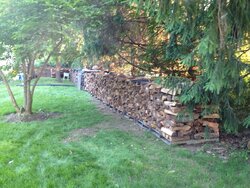Take my ignorant advice for all its worth. I'm not at all convinced that you need dry wood for a firePLACE. I burned often literally dripping wet wood in our fireplace for many years, and when we got a chimney sweep to clean prior to the stove and insert install, it was actually quite clean! Now when you have a wood stove, wood MUST be dry, or you will get a creosote problem that can be dangerous. I think you could burn any old wood now in the fireplace, and suggest you not make much of an investment in wood while it will be at a premium (winter), but after winter is over, start looking for wood you can stack/season on your property, while the price will be better.
You can buy a grate for the fireplace (to put the logs on), screen (to keep flying sparks from burning holes on your floor, or worse), and tools (poker, grabber/tongs, shovel) all on Craigslist. You will not need the grate or screen if you upgrade to a stove in the coming years, and there will probably be other people upgrading their fireplaces and looking to get rid of their fireplaces accessories on Craigslist, like we just did. Some of the tools you will use with the wood stove, but you won't need them as much- the grabber/tongs I still use.
In Michigan, you will find a stove quickly pays for itself, even if you spend a lot of money for new stoves and hire someone for the installs, like we did. Here in Virginia, our payback time will take much longer. But we have no regrets, are loving the stoves for higher temps in the house without guilt, ecological reasons, resiliency/emergency reasons.
You will soon learn if your fireplace actually imports cold air into your house, when it is not burning. We had two fireplaces/chimneys. One was no problem, but the other one had a backdraft down the flue that I called the Arctic express. Even with the damper closed, the amount of cold air that came into the room, and spread to the adjacent rooms, was enormous. Now (even with no burning in the stove), there is no cold air coming in, because a wood stove with its chimney is a closed system. I feel like having the stove there, even without burning in it, actually is saving us money by plugging the huge cold air channel to the outdoors. (Of course our "no problem fireplace" probably just let all the heat out, through the chimney, and we would not have been able to tell- again, problem solved with the closed system of a wood stove.)
This forum is fun, take this winter and spring to read and learn, and then make some educated decisions. I discovered the group just a few days before we committed to our stoves, and it really helped finalize our decisions. Now that we have them installed, you'd think I'd be done here, but it's helped so much with the learning curve of how to operate the stoves. I had some inkling that this would be a lifestyle change for us, and it's true- the whole storing and drying the wood takes time and planning- but like many others here, I find it a fun new hobby. The group is well-moderated, and everyone will help you with your questions.


